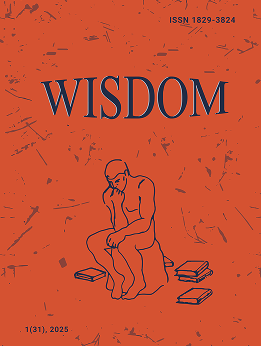Socio-Adaptive Thinking of Searching for an Architectural Connection to Improve the Lives of Students with Special Physical Needs as a Special Kind of Philosophical Communication
DOI:
https://doi.org/10.24234/wisdom.v18i2.491Keywords:
socio-adaptive, physical needs, philosophical communication, architectural environment, persons with disabilitiesAbstract
An analysis of the spiritual situation in the modern, in particular the Western, world prompts the idea that a person's place in it is becoming increasingly uncertain and contradictory. This is especially evident in the context of various conflicts arising among people with disabilities due to infrastructure problems in educational institutions. It is obvious that disabled people and various categories of mentally and physically weakened people are a very significant part of our society, for which accessible and comfortable conditions of life and rehabilitation should be created. This requirement should be considered among the fundamental, and it should apply to many significant objects of the social infrastructure of modern cities, including their higher educational institutions. The major purpose of this article is to determine the ways of adapting the architectural environment of higher education institutions to the needs of persons with disabilities. The object of the research is the buildings and structures of higher education institutions. To achieve the goal of our research we have used a IDEF0 model in the context of achieving social adaptation and improving communication.
Downloads
References
Alrashidi, A. M. (2010). University education and students’ perceptions of physical disabilities at Kuwait University. Kuwait: ProQuest Publishing.
Azeri Gorji, A. A. & Shirzad Nazarloo, Z. (2018). Hashmandamneri iravunk’neri dirk’y k’aghak’ayin iravunk’i volortum (The position of rights of the disabled in the field of urban law, in Persian). Journal of Strategic Studies in Public Policy, 8(26), 137-163.
Boyer, E. L., & Mitgang, L. D. (1996). Building community: A new future for architecture education and practice: A special report. Princeton: Carnegie Foundation for the Advancement of Teaching.
Carmona, M. (2010). Contemporary public space: Critique and classification, part one: Critique. Journal of Urban Design,15(1), 123-148.
Francis, L. (2018). Understanding disability civil rights non-categorically: The Minority Body and the Americans with disabilities act. Philosophical Studies,175(5), 1135-1149.
Froehilich, D. E., Beausaert, S. A. J., & Segers, M. (2015). Great expectations: The relationship between future time perspective, learning from others, and employability. Vocation and Learning, 8, 213-227. https://doi.org/10.1007/s12186-015-9131-6
Hallgrimsdottir, B., Wennberg, H., Svensson, H., & Ståhl, A. (2016). Implementation of accessibility policy in municipal transport planning-progression and regression in Sweden between 2004 and 2014. Transport Policy, 49, 196-205.
Kamp, A. (2016). Engineering education in the rapidly changing World. Rethinking the vision for higher engineering education. Delft: TU Delft / 4TU Centre for Engineering Education.
Kurath, M. (2015). Architecture as a science: Boundary work and the demarcation of design knowledge from research. Science & Technology Studies, 28, 81-100.
Lisy, K., Campbell, J. M., Tufanaru, C., Moola, S., & Lockwood, C. (2018). The prevalence of disability among people with cancer, cardiovascular disease, chronic respiratory disease, and/or diabetes: A systematic review. International Journal of Evidence-Based Healthcare,16(3), 154-166.
Milner, P., & Kelly, B. (2009). Community participation and inclusion: People with disabilities defining their place. Disability & Society, 24, 47-62
Mitra, S., & Sambamoorhi, U. (2006). Employment of persons with disabilities: Evidence from the National Sample Survey. Economic and Political Weekly, 41, 4022-4026.
Rijst, R., Baggen, Y., & Sjoer, E. (2018). University teachers’ learning paths during technological innovation in education. International Journal for Academic Development. https://doi.org/10.1080/1360144x.2018.1500916
Rosano, A., Mancini, F., & Solipaca, A. (2009). Poverty in people with disabilities: Indicators from the capability approach. Social Indicators Research, 94, 75-82.
Salmela, J. (2019). Research & Development project concerning the inclusion of students with special needs. Malmö: ProQuest Publishing.
Segrest, R. (1997). The architecture of architectural education. Assemblage, 33, 76-79. https://doi.org/10.2307/3171382
Shahraki, A. A., Ebrahimzadeh, I., & Kashefidoost, D. (2016). Distributional planning of educational places in developing cities with case studies. Habitat International, 51, 168-177.
Simons, M., & Masschelein, J. (2009). The public and its university: Beyond learning for civic employability? European Educational Research Journal, 8(2), 204-217.
Steen, M., Manschot, M. A. J., & de Koning, N. (2011). Benefits of co-design in service design projects. International Journal of Design, 5(2), 53-60.
Townsend, P. (1985). A sociological approach to the measurement of poverty: A rejoinder to Professor Amartya Sen. Oxford Economic Papers, 37, 659-668.
Van Dooren, E., Boshuizen, E., van Merriënboer, J., Asselbergs, T., & van Dorst, M. (2014). Making explicit in design education: Generic elements in the design process. International Journal of Technology and Design Education, 24(1), 53-71.
Vermeersch, P., & Heylighen, A. (2012). Blindness and multi-sensoriality in architecture. The case of Carlos Mourão Pereira. In R. Hayes, & V. Ebbert (Eds), The place of research, the research of place. ARCC/EAAE 2010 international conference on architectural research (pp. 393-400) Washington DC: Architectural Research Centers Consortium (ARCC).
White, H., Saran, A., & Kuper, H. (2018). Evidence and Gap Map of studies assessing the effectiveness of interventions for people with disabilities’. New Delhi and London: Campbell Collaboration and International Centre for Evidence and Disability.
Wirth, T., Frantzeskaki, N., Fuenschilling, L., & Coenen, L. (2018). Impacts of urban living labs on sustainable transitions: Mechanisms and strategies for systemic change through experimentation. European Planning Studies. https://doi.org/10.1080/09654313.2018.1504895
Downloads
Published
How to Cite
Issue
Section
License
Copyright (c) 2021 Author and scientific journal WISDOM

This work is licensed under a Creative Commons Attribution-NonCommercial 4.0 International License.
Creative Commons Attribution-Non-Commercial (CC BY-NC). CC BY-NC allows users to copy and distribute the article, provided this is not done for commercial purposes. The users may adapt – remix, transform, and build upon the material giving appropriate credit, and providing a link to the license. The full details of the license are available at https://creativecommons.org/licenses/by-nc/4.0/.















